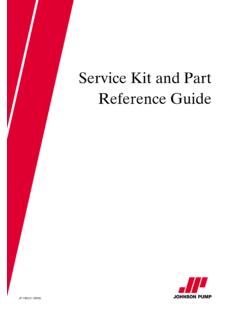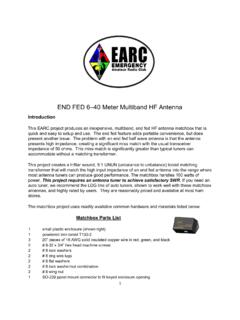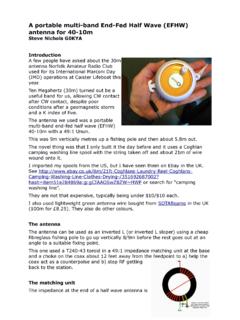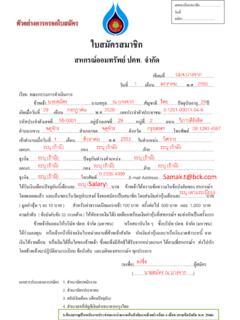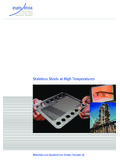Transcription of Magnetic Longwire Balun : The Original - devill.net
1 Magnetic Longwire Balun : The Original by RF Systems The Magnetic Longwire Balun makes it possible to use a coaxial lead-in cable with all forms of Longwire , windom-, or other types of wire antenna. The MLB contains a special impedance matching transformer, which converts any piece of wire between 6 and 20 metres long into a wide-band receiving antenna, without the need for an antenna tuner. Advantages: A coaxial cable lead-in reduces the interference pick-up from nearby fluorescent lights, dimmers,thermostats,and computers to a minimum. The Magnetic Longwire Balun offers extremely broadband performance between 100 kHz - 40 MHz without the need for an antenna tuner. The Magnetic Longwire Balun is passive. No intermodulation products are generated. The Magnetic Longwire Balun offers increased signal strength, thanks to improved impedance matching between the antenna and lead-in cable. Signals received by the antenna are transferred to the receiver by means of a Magnetic field.
2 This reduces the level of static noise. The antenna is directly connected to earth, hence static build-up on the antenna (which can damage sensitive front-end circuitry) is eliminated. Wire Antennas Longwire and T-style antennas (which are centre fed) are some of the most tried and tested designs throughout the world. They are simple to construct, and yet providing they are high and long enough, performance is excellent over a large frequency range. They contain no electronic parts which could add extra noise or intermodulation products to the received signal. The Longwire type of antenna is less sensitive to the effects of fading, caused by multi-path propagation. But there are also disadvantages. The main problem is that the ideal Longwire antenna should be at least three times longer than the wavelength of the lowest frequency to be received. So a Longwire antenna for the 49 metre band would have to be at least 150 metres long.
3 In practice, in most suburban situations, such a huge antenna is impractical. But even if space is available, the next problem is the impedance. For frequencies where the length of the antenna is three wavelengths or more, the impedance of the antenna is approx. 600 ohms. That's the reason why coaxial lead-in cable cannot be used: the 50 ohms impedance of this cable short-circuits the high source impedance of the antenna, and no signals are left. Therefore a single wire should be used as connection between the antenna and the 600 ohms antenna input (if available) on the receiver. The wire must be'carefully mounted on insulated brackets at a reasonable distance from any wail. However, this lead-in wire is extremely sensitive to electric interference generated-in the neighbourhood, such as fluorescent lighting, light dimmers, televisions and computers. Any type of end-fed or T fed wire antenna uses the ground as counterpoise.
4 So a good ground (earth) connection is essential. If this cannot be made, and only the ground from the 110 or 230 Volts mains wiring is connected to the receiver chassis, the signal - to - noise ratio will be severely degraded, as the mains ground is polluted with interference and man-made noise. Last but not least: most wire antennas such as dipoles, G5RV's, windoms and standard longwires are effectively isolated from ground. During very dry weather and with thunderstorms in the vicinity extremely high static voltages are induced, which can damage the sensitive input circuitry of the receiver. Putting theory into practice In practice very few short-wave listeners use a full-length Longwire antenna, mainly due to space limitations. On the other hand, single wire antennas are cheap to construct, so often a short end-fed wire with a length up to 20 metres (depending of the space available) is used. Although not really correct, these are mostly also called longwires.
5 Reducing the size of the antenna does not mean necessarily poorer reception. The reason is, that for frequencies up to 20 MHz, the atmospheric noise (especially man-made) is high, and even very high on frequencies lower than 5 MHz. Remember that a station can be only heard out of the loudspeaker or headphones, if its signal is stronger than the noise. If the antenna size is reduced, not only is the signal strength of the station lower, but also the level of the received noise. The signal - to -noise ratio remains the same: Even if the size of the antenna is reduced to a single point - an isotropic antenna- the level of the received signals fall only by dB, hardly noticeable on the S-meter. This means that the size of a receiving antenna for short-wave is not very important. But with a reduced size, the impedance of the antenna is no longer 600 Ohms. A short antenna behaves as though it were a small resistor in series with a small capacitor.
6 The value of the resistor is not more than a few Ohms (depending on the size and material of the wire) and can be ignored for receiving antennas. The small capacitor forms the internal impedance of the antenna. The impedance of the antenna is therefore dependent of the frequency: very high capacitive for lower frequencies, reducing to low Ohmic values when the antenna length is 1/4 of the wavelength of the received signal. Due to the very high and changing impedance of longwires shorter than 1/4 wavelength, it is not longer possible to connect the antenna to the 50 Ohms antenna input of the receiver. The receiver short-circuits the high impedance antenna, With very bad reception resulting, especially on lower frequencies. Up until the invention of the Magnetic Longwire Balun , the only solution to this problem was the use of an antenna tuner. An antenna tuner transforms the impedance of the antenna to the 50 ohms impedance of the receiver.
7 Because the impedance of the antenna changes with the frequency, the tuner has to be re - aligned with every change of the listening frequency. Twiddling on three knobs makes computerised- or memory tuning impossible, and the sensitivity of the single lead-in wire for interference remains the same. THE SOLUTION: THE Magnetic Longwire Balun The Magnetic Longwire Balun is a compact, weather-proof matching unit. In contrast to cheap copies, the MLB is not just a simple 1: 9 transmission line transformer (unun). This Original Magnetic Longwire Balun , invented by RF Systems, is based on an impedance matching transformer with completely separated antenna- and receiver circuits sharing a common ground. The transformer makes use of a special ferrite, developed at RF Systems. This makes It possible to transfer signals with extremely low loss from the antenna to the receiver, only by using a Magnetic field. There is no direct connection between the antenna and the receiver.
8 This Magnetic transfer technology reduces the overall background noise, caused by statics. The MLB grounds the antenna wire. This ensures that any static charges from nearby thunderstorms can safely leak away to the ground. An important point is that the MLB is mounted in between the antenna wire and the coaxial lead-in cable. The outer screen of the coax is used as counterpoise for the antenna. This changes totally the behaviour of the antenna compared to ,a normal single wire lead-in. The MLB makes use of the fact that the signals on the screen of the coax and the antenna wire never have the same amplitude and phase, hence the name Balun . The RF Systems Magnetic Longwire Balun is designed to give good reception with short end-fed or T fed wire antennas. The MLB is a simple device which you connect to the end of a short Longwire antenna (or in the middle of a "T" antenna). The other end of the MLB has an SO-239 socket for the connection of 50 ohms coaxial lead-in cable to the receiver.
9 The advantages are immediate. The lead-in cable is immune from local man-made interference, and doesn't have to be isolated from its supports. There is no reason why the antenna cannot be set up on one side of the house, and a coaxial cable run to the listening location on the other side of the building, or even in the basement. But there is more! Dipoles, Trap-dipoles such as W3 DZZ antennas and even the G5RV give good reception on a single, or a number of frequency bands. In between those frequency bands, the antenna impedance is not equal to the impedance of the receiver, with poorer reception as result. These "sensitivity gaps" are not longer present using a Longwire with MLB. The special impedance matching transformer inside the MLB matches the high, capacitive impedance of the short Longwire to the low impedance of the coaxial cable and the receiver input. The inductive impedance of the matching transformer changes inversely to the changing capacitive antenna impedance, resulting in maximum signal transfer, practically independent of the frequency.
10 This means that a short Longwire (up to 20 metres) has roughly equal sensitivity for all frequencies, without the use of an antenna tuner. Specifications Antenna connection: nickelized brass terminal screw Coaxial cable connector: SO 239 Max. coaxial cable length: 50 metres RG 58/u Frequency range: 100 kHz - 40 MHz +- 2 dB Transfer loss: less than dB Dimensions : 8 x cm Recommended antenna length : 12 metres or more Max. power transfer: 1 Watt, antenna is for reception purposes only Operating conditions: waterproof, UV resistant - 30 to + 70 C operating temp. Instructions Constructional suggestions The Magnetic Longwire Balun from RF Systems performs best using at least 12 to 20 metres of wire. You can use a longer length if space permits. This give a better reception on long- and medium wave, but the effects on shortwave (3 - 22 MHz) will only be marginal. The reception above 22 MHz deteriorates slightly with lengths above 20 metres.

